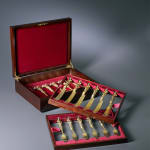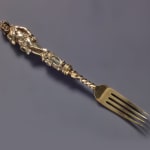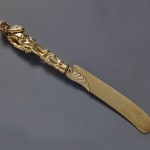Francis Higgins and Son
Further images
A beautiful set of late Victorian Sterling silver-gilt dessert knives, forks and spoons for six settings by Francis Higgins and Son, each of the eighteen pieces fully hallmarked and housed in their original red velvet lined mahogany box, enclosing two removable and one fixed tray. Each of the six knives with its handle formed as a young Bacchus with vine leaves and grapes in his hair, his left hand holding fruit which he holds up to his mouth while in his right hand he holds a bunch of grapes resting beside his knee, wearing nothing other than a vine leaf he stands on a plinth with a blank scrolled oval reserve above an acanthus leaf adorning the top of the knife blade. Each of the six forks with four sharp prongs and handle of similar form to that of the knife composed of a standing young Bacchus with clusters of grapes in his hair, wearing nothing other than a vine leaf which is attached to a stalk supporting a small bunch of grapes held beside his left hip while his right arm is bent upward toward his chest where his hand wraps around a vine trail stem, again he stands on a plinth with a blank scrolled oval reserve but here it is further adorned by a vine leaf in one corner, above a twisted stem. Each of the six spoons with its handle formed as a beautiful female Bacchante with clusters of grapes and vine leaves in her long flowing hair, her head bent slightly backward and to one side and supported behind in her left hand as if in ecstasy, holding a bunch of grapes in her right hand which crosses just below her bare breast and supports a scanty vine-clad cloth wrapped around her lower half, standing with her knees crossed and entwined around a vine spray upon the top of the twisted stem of the spoon
London, dated 1872
Each piece fully hallmarked
Francis Higgins & Son who made this beautiful set of dessert knives, forks and spoons was one of the most important firms of Victorian silversmiths specialising in this field, only to be rivalled by Chawner & Co and Henry Holland and his successors. As a leading maker of knives, forks and spoons, much of Francis Higgins’s work was supplied to the finest retail outlets, most notably Hunt and Roskell as well as R & S Garrard & Co, though they also made pieces for other reputed retailers. Renowned for the excellent quality of their work, the firm issued many unusual naturalistic novelties, of which the present set is exemplary of their creative ingenuity and refinement of work. Their craftsmanship was appreciated by the public and art critics alike. For instance, in 1848, The Art Union praised the firm’s production as “remarkable for their elegant simplicity, or elaborate and rich workmanship; manufactured too as a price which brings them within reach of a class not absolutely wealthy. Instead of fiddles, and such matters whereupon to base his designs the party in question has had recourse to the beautiful forms of nature – the leaves and buds of the rose, and other flowering plants, which he has adapted…They may, we are informed be procured of any respectable silversmith, either in London or in the provincial towns.” (cited in John Culme, “The Directory of Gold & Silversmiths Jewellers & Allied Traders 1838-1914”, 1987, p. 230).
The same interest in naturalism remains paramount in the design of the present set. Here the figures of the young Bacchus, entwined with vine sprays, form the handles of the knives and forks while the spoon handles are composed of beautiful Bacchantes (likewise adorned by grapes and vines), whose forms perfectly compliment the rounded or more female shape of the spoon itself. Because of their association with grapes, Bacchus, the mythological god of wine and his female followers the Bacchantes or Maenads, were chosen to figure on the handles of these knives, forks and spoons, which could as easily be used for the dessert course as for eating fruit. In contrast, other Victorian silversmiths tended to simply featured vine sprays on such handles. But Higgins was innovative and it is partly for that reason, combined with the sheer quality of their craftsmanship, that their work still continues to be so highly sought after. The same or similar Bacchanalian figures can be seen on other pieces by Francis Higgins, including a silver letter opener of 1861 (featuring the same Bacchante) and two three-piece christening sets, one of 1862/3 and the other of 1865 (with variations in all three figures).
Although Francis Higgins’s silversmithing business is said to have been begun in 1782 John Culme proposes that this important firm’s foundation actually dates from 1817, when on 31st October Francis Higgins (b. c. 1792 d. 1880), the son of Francis Higgins, entered his first mark. At the time he was living and working at 20 Cursitor Street off London’s Chancery Lane with his newly married wife Charlotte née Brayne (whom he married on 11th October 1817). Their eldest child, also named Francis Higgins (1818-1908), who was born in Cursitor Street, was eventually to succeed his father’s silversmithing business. But before that, in 1859, Higgins junior left his father’s concern, then located in Hatton Gardens at Kirby Street, to become the manager of the ill-fated Portland Co Ltd. However, when that venture failed, owing to circumstances outside Higgins’s control, he re-joined his father as a partner in about 1868, at which date the business was changed from simple Francis Higgins to Francis Higgins & Son. Soon after the enterprise was moved to a large and specially constructed premise in Newman Street, off Oxford Street. There, father and son installed a number of pioneering pieces of machinery as well as the most advanced tools, some of which Higgins junior had designed himself. He was not only fastidious in having the most advanced machinery and tools but was extremely concerned about the quality of the firm’s goods – so much so that he is said to have carried a hammer with him, with which he would destroy any item that was not up to standard.
At the time that the present set was made, the manufacture of knives, forks and spoons was still the firm’s main concern. However, following the death of Francis Higgins senior in 1880, when Higgins junior assumed control as the business’s sole partner, he began to diversify the firm’s range of production. When Francis Higgins junior died in 1908, leaving an estate of just over £12,700, the concern was converted into a limited company with his son Francis Joseph (b. 1885) as the main director aided by the latter’s mother Hortense née Croker-Stewart and sister Marguerite (1887-1972) and others. Unlike his father F. J. Higgins was not a craftsman though he was a good businessman who was instrumental in taking over Holland, Aldwinckle & Slater which was amalgamated with Francis and Higgins and Son Ltd in 1922/3. Due to the pressures on the manufacturing trade after the outbreak of the Second World War, F. J. Higgins decided to wind down the business which eventually closed in 1940. Still prized by collectors, pieces by Francis Higgins can today be admired in a number of important collections, of which the Victoria and Albert Museum in London have numerous examples of their work.







